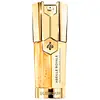What's inside
What's inside
 Key Ingredients
Key Ingredients

No key ingredients
 Benefits
Benefits

 Concerns
Concerns

 Ingredients Side-by-side
Ingredients Side-by-side

Water
Skin ConditioningGlycerin
HumectantPropanediol
SolventButylene Glycol
HumectantAlcohol
AntimicrobialEthylhexyl Stearate
EmollientPentylene Glycol
Skin ConditioningPropylene Glycol Dicaprylate/Dicaprate
EmollientTapioca Starch
Royal Jelly
Coco-Caprylate/Caprate
EmollientCellulose
AbsorbentSoybean Glycerides
EmollientHydroxyethyl Acrylate/Sodium Acryloyldimethyl Taurate Copolymer
Emulsion StabilisingSteareth-21
CleansingSynthetic Fluorphlogopite
Mel
EmollientBis-Behenyl/Isostearyl/Phytosteryl Dimer Dilinoleyl Dimer Dilinoleate
EmollientStearyl Alcohol
EmollientCI 77891
Cosmetic ColorantButyrospermum Parkii Butter Unsaponifiables
Skin ConditioningSorbitol
HumectantCetyl Alcohol
EmollientMel Extract
MoisturisingSteareth-2
EmulsifyingParfum
MaskingChlorphenesin
AntimicrobialCaprylyl Glycol
EmollientPolyglyceryl-10 Stearate
Skin ConditioningMangifera Indica Seed Butter
Skin ConditioningPolyglycerin-4
HumectantWater, Glycerin, Propanediol, Butylene Glycol, Alcohol, Ethylhexyl Stearate, Pentylene Glycol, Propylene Glycol Dicaprylate/Dicaprate, Tapioca Starch, Royal Jelly, Coco-Caprylate/Caprate, Cellulose, Soybean Glycerides, Hydroxyethyl Acrylate/Sodium Acryloyldimethyl Taurate Copolymer, Steareth-21, Synthetic Fluorphlogopite, Mel, Bis-Behenyl/Isostearyl/Phytosteryl Dimer Dilinoleyl Dimer Dilinoleate, Stearyl Alcohol, CI 77891, Butyrospermum Parkii Butter Unsaponifiables, Sorbitol, Cetyl Alcohol, Mel Extract, Steareth-2, Parfum, Chlorphenesin, Caprylyl Glycol, Polyglyceryl-10 Stearate, Mangifera Indica Seed Butter, Polyglycerin-4
Water
Skin ConditioningGlycerin
HumectantTribehenin
EmollientCaprylic/Capric Triglyceride
MaskingIsodecyl Neopentanoate
EmollientGlyceryl Stearate
EmollientPropanediol
SolventSqualane
EmollientAcrylamide/Sodium Acryloyldimethyltaurate Copolymer
Emulsion StabilisingLeuconostoc/Radish Root Ferment Filtrate
AntimicrobialCaprylyl Glycol
EmollientBakuchiol
AntimicrobialSodium Ascorbyl Phosphate
AntioxidantCeramide NP
Skin ConditioningRosa Canina Seed Oil
EmollientAdansonia Digitata Seed Oil
EmollientArgania Spinosa Kernel Oil
EmollientGlycyrrhiza Glabra Root Extract
BleachingPfaffia Paniculata Root Extract
SoothingPtychopetalum Olacoides Bark/Stem Extract
Skin ConditioningCalanthe Discolor Extract
Skin ConditioningLilium Candidum Flower Extract
Skin ConditioningUbiquinone
AntioxidantSuperoxide Dismutase
AntioxidantErgothioneine
AntioxidantTocopheryl Acetate
AntioxidantBisabolol
MaskingAllantoin
Skin ConditioningBiotin
AntiseborrhoeicHesperidin Methyl Chalcone
AntioxidantMethylglucoside Phosphate
Skin ConditioningCopper Lysinate/Prolinate
Skin ConditioningPalmitoyl Tetrapeptide-7
Skin ConditioningChrysin
Skin ConditioningGluconolactone
Skin ConditioningDipeptide-2
Skin ConditioningPalmitoyl Tripeptide-1
Skin ConditioningN-Prolyl Palmitoyl Tripeptide-56 Acetate
Skin ConditioningCalcium Gluconate
HumectantN-Hydroxysuccinimide
Skin ConditioningCaprylyl/Capryl Glucoside
CleansingCitric Acid
BufferingGlyceryl Polyacrylate
Isohexadecane
EmollientPentylene Glycol
Skin ConditioningPolysorbate 80
EmulsifyingSodium Citrate
BufferingSodium Gluconate
Skin ConditioningSodium Hydroxide
BufferingSorbitan Oleate
EmulsifyingSteareth-20
CleansingXanthan Gum
EmulsifyingBenzyl Alcohol
PerfumingChlorhexidine Digluconate
AntimicrobialSodium Benzoate
MaskingPotassium Sorbate
PreservativePhenoxyethanol
PreservativeWater, Glycerin, Tribehenin, Caprylic/Capric Triglyceride, Isodecyl Neopentanoate, Glyceryl Stearate, Propanediol, Squalane, Acrylamide/Sodium Acryloyldimethyltaurate Copolymer, Leuconostoc/Radish Root Ferment Filtrate, Caprylyl Glycol, Bakuchiol, Sodium Ascorbyl Phosphate, Ceramide NP, Rosa Canina Seed Oil, Adansonia Digitata Seed Oil, Argania Spinosa Kernel Oil, Glycyrrhiza Glabra Root Extract, Pfaffia Paniculata Root Extract, Ptychopetalum Olacoides Bark/Stem Extract, Calanthe Discolor Extract, Lilium Candidum Flower Extract, Ubiquinone, Superoxide Dismutase, Ergothioneine, Tocopheryl Acetate, Bisabolol, Allantoin, Biotin, Hesperidin Methyl Chalcone, Methylglucoside Phosphate, Copper Lysinate/Prolinate, Palmitoyl Tetrapeptide-7, Chrysin, Gluconolactone, Dipeptide-2, Palmitoyl Tripeptide-1, N-Prolyl Palmitoyl Tripeptide-56 Acetate, Calcium Gluconate, N-Hydroxysuccinimide, Caprylyl/Capryl Glucoside, Citric Acid, Glyceryl Polyacrylate, Isohexadecane, Pentylene Glycol, Polysorbate 80, Sodium Citrate, Sodium Gluconate, Sodium Hydroxide, Sorbitan Oleate, Steareth-20, Xanthan Gum, Benzyl Alcohol, Chlorhexidine Digluconate, Sodium Benzoate, Potassium Sorbate, Phenoxyethanol
Ingredients Explained
These ingredients are found in both products.
Ingredients higher up in an ingredient list are typically present in a larger amount.
Caprylyl Glycol is a humectant and emollient, meaning it attracts and preserves moisture.
It is a common ingredient in many products, especially those designed to hydrate skin. The primary benefits are retaining moisture, skin softening, and promoting a healthy skin barrier.
Though Caprylyl Glycol is an alcohol derived from fatty acids, it is not the kind that can dry out skin.
This ingredient is also used as a preservative to extend the life of products. It has slight antimicrobial properties.
Learn more about Caprylyl GlycolGlycerin is already naturally found in your skin. It helps moisturize and protect your skin.
A study from 2016 found glycerin to be more effective as a humectant than AHAs and hyaluronic acid.
As a humectant, it helps the skin stay hydrated by pulling moisture to your skin. The low molecular weight of glycerin allows it to pull moisture into the deeper layers of your skin.
Hydrated skin improves your skin barrier; Your skin barrier helps protect against irritants and bacteria.
Glycerin has also been found to have antimicrobial and antiviral properties. Due to these properties, glycerin is often used in wound and burn treatments.
In cosmetics, glycerin is usually derived from plants such as soybean or palm. However, it can also be sourced from animals, such as tallow or animal fat.
This ingredient is organic, colorless, odorless, and non-toxic.
Glycerin is the name for this ingredient in American English. British English uses Glycerol/Glycerine.
Learn more about GlycerinPentylene glycol is typically used within a product to thicken it. It also adds a smooth, soft, and moisturizing feel to the product. It is naturally found in plants such as sugar beets.
The hydrophilic trait of Pentylene Glycol makes it a humectant. As a humectant, Pentylene Glycol helps draw moisture from the air to your skin. This can help keep your skin hydrated.
This property also makes Pentylene Glycol a great texture enhancer. It can also help thicken or stabilize a product.
Pentylene Glycol also acts as a mild preservative and helps to keep a product microbe-free.
Some people may experience mild eye and skin irritation from Pentylene Glycol. We always recommend speaking with a professional about using this ingredient in your routine.
Pentylene Glycol has a low molecular weight and is part of the 1,2-glycol family.
Learn more about Pentylene GlycolPropanediol is an all-star ingredient. It softens, hydrates, and smooths the skin.
It’s often used to:
Propanediol is not likely to cause sensitivity and considered safe to use. It is derived from corn or petroleum with a clear color and no scent.
Learn more about PropanediolWater. It's the most common cosmetic ingredient of all. You'll usually see it at the top of ingredient lists, meaning that it makes up the largest part of the product.
So why is it so popular? Water most often acts as a solvent - this means that it helps dissolve other ingredients into the formulation.
You'll also recognize water as that liquid we all need to stay alive. If you see this, drink a glass of water. Stay hydrated!
Learn more about Water